
Is cereal really dessert in disguise?
Scan a typical grocery store aisle. With about 130 varieties of cold cereal, each box yelling its seductive “low sugar!” “high fiber!” “great source of whole grains!” health claims, it’s easy to feel, well, bowled over. “Some cereals are as healthy as salad, others are like scarfing down a chocolate eclair,” Dawn Jackson Blatner, RD, author of The Flexitarian Diet, recently told Health magazine. “But while there are a lot of sugary cereals, happily, it’s easier than ever to find a really nutritious one.” Here’s how to find the healthiest cereal for you.
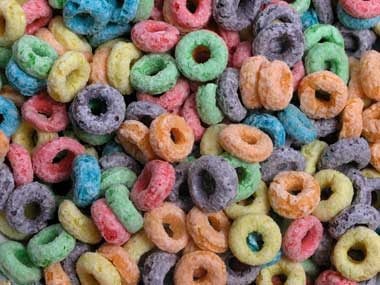
When your healthy cereal is a sugar bomb
Grab your favorite cereal box and look at the ingredient list: You may be shocked to see that some form of sugar appears—perhaps multiple times—in the first few ingredients. “Even if a cereal is made from whole grains or loaded with other healthful ingredients, a high sugar content disqualifies it from my list of top picks,” Today contributor and nutrition expert Joy Bauer, RD, says. Too much sugar adds unnecessary calories, and it also spikes your blood sugar and primes you for a mid-morning energy dip. Enter snack cravings!
Healthy cereal makeover: Expert recommendations vary, but most say look for fewer than 5 to 8 grams of sugar per serving. (Don’t judge a box by its cover: Quaker Honey Graham Oh!s cereal, for instance, has 12 grams, while Lucky Charms cereal has 10 grams.) For great options, check out FitSugar’s list of low-sugar cereals, where most have 5 grams or fewer. If you still can’t give up on your favorite, mix it with a serving of low-sugar cereal.
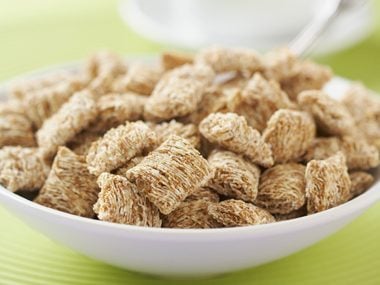
When your healthy cereal skimps on whole grains
Whole grains are linked to weight loss and a decreased risk of diabetes and heart disease, and a bowl without them should be a deal-breaker. But it can be confusing, thanks to misleading front-of-box claims like “More whole grain than any other ingredient!” and “with whole grain first ingredient.” The Nutrition Action Healthletter, a newsletter from the watchdog group The Center for Science in the Public Interest (CSPI), warns that in roughly half the cereals that make those claims, the second ingredient is refined.
Healthy cereal makeover: The label you’re looking for is “Made from 100% whole grain.” Check the ingredient list—the first ingredient should be preceded by the word “whole.” One exception is bran, which can’t call itself 100% whole grain, but is still a great source of fiber. Ideally, the first two ingredients should be whole grain, bran, fruit, or soy, according to the CSPI’s “Best Bites” rating system. Some that make the cut: Post Bran Flakes, Kashi GOLEAN, and General Mills Fiber One 80 Calories.
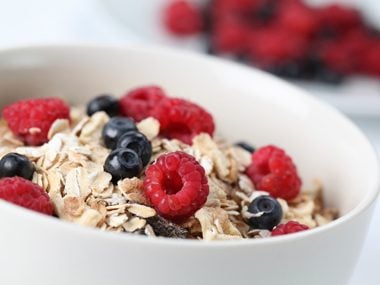
When your healthy cereal contains fake fiber
Fiber deserves a place in the Nutrition Hall of Fame for its ability to promote fullness and lower the risk of certain chronic diseases, but cereals that boast of sky-high levels are probably using added isolated fibers such as chicory root fiber, soy fiber, or psyllium. The Nutrition Action Healthletter says that there “isn’t good evidence that these lower the risk of heart disease, constipation, and diabetes the same way intact fiber, the kind in the outer layer of whole grains, does.” And research suggests that inulin (chicory root) doesn’t give you the same fullness as innate fiber, according to Health magazine.
Healthy cereal makeover: Choose cereals with at least 3 to 5 grams of fiber, but be skeptical of claims like “40 percent of your daily fiber,” warns the Nutrition Action Healthletter, which is a sign the fiber isn’t the natural kind. Of course, the easiest way to pump up the fiber in any cereal: Top it with fruit. A half-cup of raspberries has 4 grams, about 17 percent of your daily need.
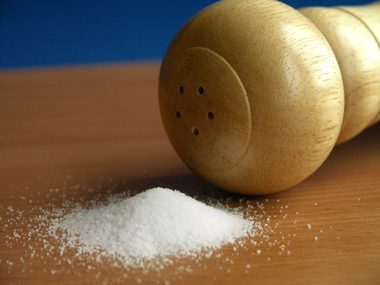
When your healthy cereal is pumped with sodium
You’ve probably heard that our national love affair with salt is more a result of processed foods in our diets than the stuff in the shaker itself. Sneaky sodium packed into foods that don’t taste salty (like cereal) tricks our taste buds into craving salt, which can lead us to other waistline-padding junk food.
Healthy cereal makeover: To make the cut for Self’s Healthy Food Award guidelines, cereals have no more than 250 milligrams of sodium per cup. (Kelllogg’s Raisin Bran, for example, has 210 mg.) However, we often eat more than the serving size—so be mindful before you reach for seconds.
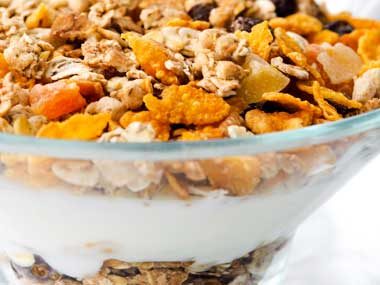
When your healthy cereal is missing protein
If your cereal bowl is naked—pretty much just the flakes and milk—it may be too low on protein to keep you sufficiently satiated, which can impact how well you eat all day long. In a new University of Missouri study, people who ate a high-protein breakfast (eggs and lean beef) felt more full, had fewer cravings, and were less likely to snack on high-fat, and high-sugar foods at night, compared with a group who ate a calorically equivalent bowl of cereal or no breakfast.
Healthy cereal makeover: Add a tablespoon of nuts or flaxseed to your favorite cereal for an extra protein boost, or top Greek yogurt (an excellent source of protein) with a small handful of your favorite cereal flakes for crunch.
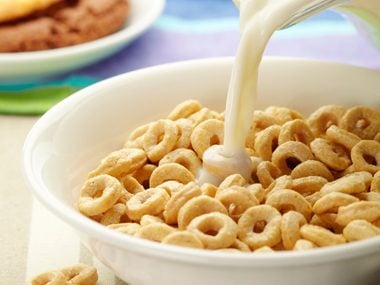
When your healthy cereal forgets to make friends with milk
The milk you add to your cereal helps make it a more nutritious meal by contributing protein, calcium, and other key nutrients. Harvard research shows that people who eat dairy foods frequently are 21 percent less likely to develop insulin resistance, and 9 percent less likely to develop type 2 diabetes. What’s more, fortified vitamins and minerals are sprayed on cereal and dissolve in milk, according to Health. If you don’t drink all of it, you miss them.
Healthy cereal makeover: If you don’t like milk, eat your cereal dry to get all of the added nutrients, and get a dairy boost from other sources, like Greek yogurt or low-fat cottage cheese, the magazine recommends.
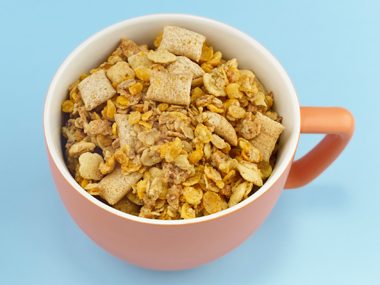
When your healthy cereal serving is too big
In a recent test of portion control savvy, Family Circle magazine volunteers poured cereal bowls that were twice as big as those recommended (1 1/2 cups and 240 calories compared to a 3/4-cup, 120-calorie serving). Do that with a calorie bomb like granola, and it could take a real toll on your waistline.
Healthy cereal makeover: Don’t assume you know what a serving size looks like! Measure it out and see how it fits into your bowl so you know how to eyeball a healthy portion. Also, consider eating with a teaspoon instead of a tablespoon, recommends Women’s Health magazine. This can make you eat more slowly and cut your overall calorie intake. Another neat tip: Eat the cereal out of a coffee cup instead of a big bowl to trick your brain into thinking you’re eating more.
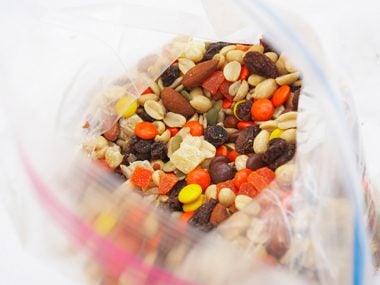
When your healthy cereal stays out on the counter
Believe it or not, keeping the box in plain sight may make you more likely to top off your bowl or take a couple of handfuls here and there all day long. Grazing like this can add up to a serving or more, says Women’s Health.
Healthy cereal makeover: Put the cereal away after you pour it. If you like to snack on your favorite flakes during the day, portion out the serving size you want in little snack-sized baggies. Consider mixing basic whole grain flakes with nuts, seeds, and mini chocolate chips for a satisfying trail mix.